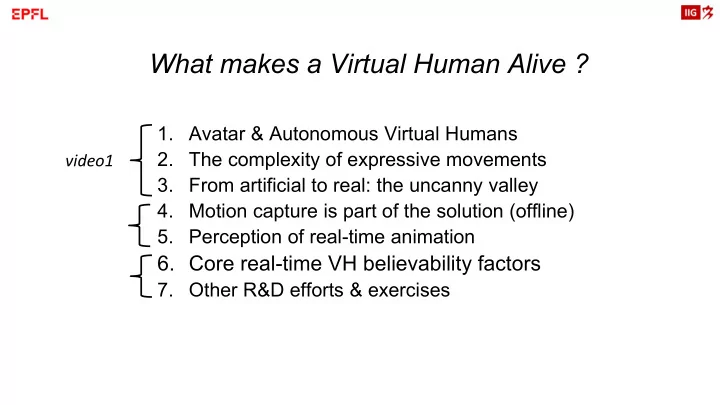

What makes a Virtual Human Alive ? 1. Avatar & Autonomous Virtual Humans 2. The complexity of expressive movements video1 3. From artificial to real: the uncanny valley 4. Motion capture is part of the solution (offline) 5. Perception of real-time animation 6. Core real-time VH believability factors 7. Other R&D efforts & exercises
1. Avatar & Autonomous Virtual Human • Avatar : [W] – (from sanskrit): is a term used in Hinduism for a material manisfestation of a deity – (computing): the graphical representation of a user. In VR the avatar movement is expected to be partially or completely driven by the user body movement • Autonomous/Intelligent Virtual Human – for the evaluation of a Virtual environment (e.g. Pedestrian from a crowd in an emergency simulation) – For training purpose: the VH takes an active part in a scenario, e.g. coach, instructor, assistant, or audience in a public speaking to overcome such a phobia, etc…
2. The complexity of expressive movements – Human expression is multi-modal: • Gestures should be considered to be “full-body” even if they seem to involve only the hands and arms. • Gestures production always includes some balance control • The body movement is linked to the gaze & facial expression • Verbalization & emotions animate the mouth and eyes • The vocal prosody reflects intentions and emotions • The tongue makes complex movements when speaking • Cloth, accessory, hairs, sweat, tears, human tissue dynamics can be important secondary movements ANVIL [K2011-17] – Analysis tools are necessary to understand part of these subtle interactions [K 2011]: • ANVIL (open source project) http://www.anvil-software.org
Annotating multi-modal human expression with ANVIL [K 2011] Video image analysis Audio track analysis Words timing Gestures timing http://www.anvil-software.org
Analyzing body expression with ANVIL [K 2011] – Tools have been proposed for analyzing the multi- modal dimensions of human expression • ANVIL (open source project) Full-body Body motion capture &analysis http://www.anvil-software.de
3. From artificial to real : the uncanny valley • uncanny : (Merriam-Webster) – a : seeming to have a supernatural character or origin : EERIE, MYSTERIOUS – b : being beyond what is normal or expected : suggesting superhuman or supernatural powers • In the 70s Masahiro Mori studied in Robotics the emotional response effect to increasing human-like appearance of still or moving entities. – His key article (in Japanese) has been translated by McDorman
Emotional response increases with % anthropomorphism Hiroshi Ishiguro http://www.youtube.com/watch?v=uD1CdjlrTBM [Masahiro Mori ]
3. From artificial to real : the uncanny valley (2) High Human sensitivity to human motion perception Turing test for computer-generated movement (Hodgins et al ~1997-98) Question: which one is synthesized from a model vs motion captured ? Differences between the left and right movements : – Variety: • temporal, style, texture, … – Coherence of the behavior: • Synergy of the whole body involved in the behavior
3. From artificial to real : the uncanny valley (3) – The paper from Masahiro Mori is questioned regarding its scientific validity (empirical experience rather than rigorous experimental protocol) – However the concept of uncanny valley has been adopted(and extended) in the field of Computer animation to adjust the human-likeness of a character's design to maximize public acceptance Unsuccessful tradeoffs (films) • Very realistic human appearances are now feasible in terms of shape, cloth, hairs, 2001: Final Fantasy (Square) skin texture and lighting Successful • BUT the quality of the associated tradeoffs animation/behavior must match the Soon on the (films) expected quality level for that level of market (NEON verisimilar appearance real-time Virtual- 2010: Avatar(J. Cameron) Human, CES2020)
[References] [H 1998] Hodgins et al.: Perception of Human Motion With Different Geometric Models, IEEE Transactions on Visualization and Computer Graphics, 4(4), 307-316 [K 2010] Kipp, M. , Multimedia Annotation, Querying and Analysis in ANVIL. In: Multimedia Information Extraction, M. Maybury (ed.), IEEE Computer Society Press, in press [Web References] http://www.anvil-software.org http://spectrum.ieee.org/robotics/humanoids/hiroshi-ishiguro-the-man-who-made-a-copy-of-himself [W] [http://en.wikipedia.org/wiki/Uncanny_Valley]
Recommend
More recommend